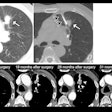For some time, interventional radiologists have been ill equipped in the ongoing battle against restenosis after revascularization procedures, according to a Canadian clinician. At Stanford University’s State-of-the-Art Interventional Radiology conference in San Francisco in June, Dr. Lindsay Machan pointed out that recurrent stenoses have been shown to develop in 30% to 60% of successfully treated coronary lesions within six months.
In addition, up to 100% of peripheral vascular lesions result in restenosis. Attempts to quell this multistep complication with drugs have been less than ideal. The formation of neointimal hyperplasia, the major lesion in chronic reocclusion, takes place in overlapping stages and eventually results in normally quiescent muscle cells migrating to the area of injury. These cells secrete extracellular matrix, which creates a scar and narrows the vascular lumen.
"At present, we don’t really have the tools that we need to carry the day," said Machan, an associate professor of radiology at University of British Columbia in Vancouver. "A whole pile of different drugs has been tried. The problem is that they are generally directed at one step [of restenosis]. As a result, biology will win every single time. It’s like when we only try to stop one step in the cancer process, we’re not going to get anywhere."
But the latest advances in local drug-delivery systems should change that, and interventional radiologists would be wise to become familiar with this up-and-coming arena, Machan said. Two systemic therapies, paclitaxel and Dexamethasone, are showing the most promise in local application.
"Basically, here’s where the interest is for us…applying the drug that you want to use at the time that you do your intervention, at the site of the intervention," he said. Machan laid out three main advantages to local drug delivery: the ability to achieve high local doses at the appropriate site, the avoidance of systemic toxicity because of these high doses, and prolonged administration because the drug can be packed inside a slow-release polymer.
Three different methods are currently under investigation for applying these drugs: intraluminal, intramural, and perivascular.
The most common method of intraluminal delivery involves either a conventional stent covered with a drug-delivery polymer, or a resorbable device where the stent dissolves and the drug is released.
"Depending on which polymer you put them in, you can release [the drug] rather quickly or in a slow phase," Machan explained.
In intramural delivery, various devices, such as drug-infusion catheters or a double-balloon catheter, can be used to send medication into the wall of the vessel. The device is coated with a thin layer of hydrophilic polyacrylic acid polymer, which absorbs the drug. The drug is then pressed into the arterial wall during balloon inflation.
Finally, with perivascular delivery, drug application can be achieved without endoluminal manipulations, and there is less restriction on how much medication-releasing polymer can be used. In a study Machan worked on, paclitaxel was encased in an ethylene vinyl acetate polymer and applied to the periadventitial space in 70 rats. The technique demonstrated a "complete and invariable prevention or neointimal response after balloon injury. No interference of wound healing or systemic effect was seen" (Cardiovascular & Interventional Radiology, 1997, Vol. 20, suppl.1, p.87).
"This is the most logical approach to restenosis. We’re used to working inside a blood vessel and so we think, ‘Why would you do [periadventitial drug delivery]?’ You can put whatever volume of drug you want on the outside and that’s the site where the pleuroperitoneal cells hang out," he said.
As with any new technique, there are drawbacks to these various delivery systems, Machan pointed out. Gaining approval from the U.S. Food and Drug Administration for endoluminal applications is a formidable task. Intramural delivery using balloons can cause damage to the arterial walls. And while perivascular delivery does show the most promise, the effect of blood flow on drug distribution still needs to be assessed.
"I don’t think there’s any one clear winner at the present time," Machan said. "These [techniques] do work, but there are some issues that need to be worked out. Still, given what’s happening now, I predict that you’ll see drug-delivery stents in clinical practice shortly." Keeping an eye on how these various trials play out will give interventional radiologists a particular claim to drug-delivery procedures, he added.
By Shalmali Pal
AuntMinnie.com staff writer
July 13, 2000
Let AuntMinnie.com know what you think about this story.
Copyright © 2000 AuntMinnie.com















